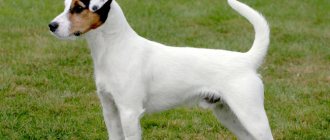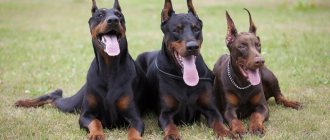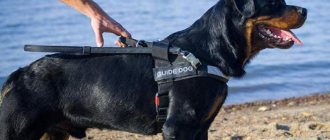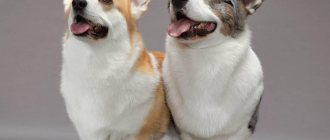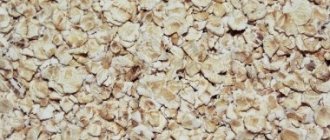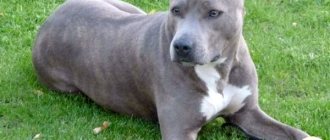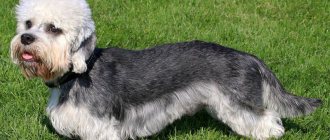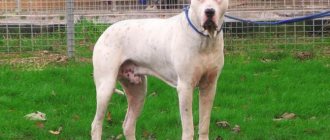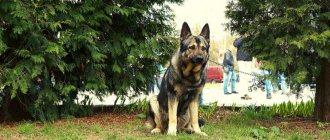Dogs are one of the most common pets around the world. Many breeders know every little detail that somehow relates to their beloved pets. Or not any? Take, for example, a dog’s toes: do you know how many there are on each animal’s paw? In this article we will look at this interesting question, and also tell you what role these organs play in the life of an animal.
While your dog's eyes, ears and tail are especially expressive, don't underestimate the power of their paws! The health of the animal’s body directly depends on their condition and, in particular, the condition of the fingers. They allow the dog to run and play happily, constantly pleasing its owner.
How is a dog's paw constructed?
A dog is a digitigrade animal, which means that it is the toes that cope with more load during walking and running than the heels.
A dog's paw has 4 toes. But there are breeds of animals that can have 5 or even 6 fingers. These “extra” fingers are called dewclaws. Most often found on the hind legs, and sometimes on both legs at once. This is due, first of all, to the fact that most breeds of this animal originated from the wolf (huskies, hounds).
Atavism is the appearance of an extra toe on a dog’s paw. It is possible that wolves are also susceptible to this feature, but they are not under supervision, and it is impossible to say for sure about this.
There are as many toes on the hind paws as there are toes on the dog's front paws. Unlike people, they cannot move them, but they still have mobility. Animals walk as if on tiptoes, thanks to which they are able to quickly change the direction of running.
Normal and abnormal number of toes in dogs
Dogs of any breed have five toes on their front paws, four of which are fully developed, and the fifth is located on the side of the paw. The dog has four fully developed toes on its hind legs, but this is normal; there are also five-toed individuals. The fifth toes on the hind legs are called dewclaws or wolf-like, which indicates a decrease in the suppression of genes passed on to dogs from ancient ancestors.
For a long time, dewclaws were considered a fault in some purebred dogs and were docked in puppies immediately after birth. Today, the international convention for the protection of animal rights prohibits the docking of body parts unless there is a medical indication for it. However, this rule does not work in all countries; many breeders still dock the tails, ears and dewclaws of dogs.
On what basis the conclusion was made about the uselessness of the fifth, dewclaws on the front and hind legs of dogs is still not clear. While the functionality of the hind paws can still be debated, the benefit of the fifth toes on the front paws is obvious.
If you watch a dog playing with a ball, you will notice that he uses his fifth finger to hold the toy. Many wildlife films feature scenes of wolves or other wild dogs hunting. If you look closely at how wolves hold their prey, you will notice that all the fingers of their paws are involved in fixing and applying pressure.
There was only one extremely reasonable argument in the argument for removing the fifth toes on the hind legs of purebred dogs. During games, walks, and work, dogs often caught with their long claws, which led to serious injuries. Since torn claws and especially toes are a very painful and long-healing injury, dewclaws began to be removed exclusively for working dogs. Just a few years later, this trend spread to non-working and even show dogs. Note that some breed standards still have recommendations for removing dewclaws if newborn puppies have them.
Extra toes in dogs are called wolf or dewclaws, but in biology there is a separate term for this phenomenon - atavism. Atavism is the identification of characteristics that were present in ancient ancestors, species, subspecies. The atavism of modern animals is a tool that their ancestors once used. In the process of evolution and progress, some organs and devices have lost their relevance.
Atavisms include the sixth toe on the front paw, the fifth toe on the hind paw, and the third eyelid in some dog breeds.
Such a phenomenon as a dewclaw is not rare. It is known that many breeds of dogs, especially those bred for hunting and hunting, were obtained by crossing with wild dogs, including wolves. It is interesting that wolves themselves descended from animals that have similar features not only to the canid species. It is not clear why fifth toes on the hind legs appear in modern purebred puppies. There are quite a lot of versions. However, most breeders, scientists and zoologists come to the conclusion that the fifth toes on the hind legs are a hereditary trait passed on from the mother or father.
The appearance of fifth toes on the hind legs is considered a recessive trait. Simply put, normally the gene responsible for the formation of the fifth toe on the hind paw should be suppressed, but this does not always happen, and the reason for this is unknown.
Despite prejudice, extra toes in dogs would be considered an anomaly, but they are not a pathology. Dewclaws are perfectly acceptable and, in some breeds, natural. Moreover, some native breeds belonging to the hunting class must have dewclaws according to the standard.
Why does an extra finger appear?
Experts say that the appearance of an extra toe in a dog is a manifestation of atavism. Atavism is a biological process of manifestation in an animal of signs of the class or group whose representatives participated in the breeding of this organism. Over time, these signs lose their functions.
If we talk about how many fingers most dogs should have, then according to the law of biology - 5, perhaps, like their distant genetic ancestor - the wolf. This means that the appearance of an extra finger is a natural pattern.
There is still a debate among experts about why some puppies develop such a toe and others do not. There is an opinion that this is due to the fact that the sign of the appearance of an extra element is a suppressive process. And if you cross a male with five fingers with a female with a normal paw, then the puppies will most likely be born like the father.
You cannot judge its health by how many toes a dog has on its paw. The presence of a “fifth” finger is not considered a pathology; only proper and careful care is required.
Claws and care for them
If your dog spends most of his life at home or in an enclosure, you should take a closer look at his claws more often. As can be understood from the above, there are four of them on each paw. Dogs' claws grow constantly (just like human nails). In cases where the nails do not wear down naturally, your pet's health may be at risk. Being overgrown, they make walking and running difficult, and also cause severe pain to the animal. It’s even worse when the claw plate, growing, curls up like a snail. In such cases, there is a high probability of inflammation of the entire paw. Thus, the nails should be trimmed from time to time. You just need to do it right.
Is the fifth finger useful?
If your pet is found to have an extra finger, then there is no need to sound the alarm; this phenomenon is not abnormal or pathological. This feature is acceptable, and in some cases is the norm. Certain dog breeds have a fifth toe, such as hounds, huskies, or Beaucerons. Such an element, so to speak, speaks of purebredness and thoroughbredness.
For dog breeders who are keen on hunting, the presence of a dewclaw in a pet is only an aesthetic problem. During a hunt, a dog has to move much faster than in normal living conditions. In this case, the extra element on the paw interferes with running in tall grass or thickets. A protruding finger clings to grass, mud, snow and twigs in every possible way, making walking difficult.
Why are fingers and finger pads so important?
We have repeatedly emphasized that fingers are very important for the health and general well-being of the animal. This is due to the following circumstances:
- Fingers act as natural shock absorbers, smoothing out the stress that occurs when running and jumping. In addition, they also act as a brake when the dog turns sharply while running. Accordingly, the health of the joints directly depends on the health of the fingers. If they cannot absorb shock, the joint surfaces will wear out.
- Finger pads are of great importance. Like the fingers themselves, they play the role of shock absorbers and also protect the paws from hypothermia. The pads are richly saturated with blood vessels, the blood in which, constantly circulating, warms the limb. Given these characteristics, many scientists reasonably assume that the ancestors of modern dogs originated from areas with a fairly cold climate.
- The toes and pads also protect the paws when the dog moves over rough, rocky terrain. In dogs that often walk on rough surfaces (asphalt, stone), the paw pads noticeably become rougher and thicker. On the contrary, in domestic dogs the skin of the fingers in these places is quite thin, delicate and sensitive. Accordingly, she is more susceptible to traumatic factors.
- In dogs, only the pads of the toes have sweat glands. Their main role is to prevent the organ from drying out. In addition, it is with their fingers that dogs sweat, so they (like the tongue) have the function of thermoregulation. It is interesting that animals, in no way inferior to humans in this regard, can sweat profusely not only in the heat, but also when under the influence of stress factors, as well as when simply excited.
Should I remove the wolf feature or not?
Surgical removal is performed, the complexity of which depends on how many toes the dogs are considered to have extra, and on how many paws. The procedure is simple and painless. Dogs easily tolerate the operation, which is performed under local anesthesia in half an hour.
It is important to know that surgical removal is not performed on newborn puppies. It’s better to wait until the little dog’s body gets stronger.
This procedure is not necessary for dogs with five toes. Most dog breeders are in no hurry to remove this aesthetic problem, and they are not particularly interested in how many toes a dog has. It is better to remove extra toes on the front paws, as opposed to the hind paws, because they fit tightly to the skin and interfere with walking.
There are cases when dogs refused to move at all, and the whole problem was that fingers with untrimmed claws interfered with running and caused pain.
Removing an extra finger
The extra toe can be removed through surgery. The complexity and duration of the operation lies in the number of fingers removed. The operation itself is very simple and almost painless and takes place under local anesthesia. All pets tolerate it well.
IMPORTANT! Surgery to remove extra toes should not be performed on newly born puppies. You need to wait at least a couple of months until your body gets stronger.
All dogs that have an extra toe or several extra toes do not need surgery to remove toes. A significant number of pet owners do not do this, and some do not know how many toes their dogs have or that they can be removed. Therefore, dogs live peacefully and feel great all their lives with five toes on their paws.
REFERENCE! It is best to remove extra toes on the front paws. On them, the extra fingers stick very tightly to the skin and interfere with walking. There were cases when pets did not move at all, because overgrown claws on their fingers got in the way and it was painful for them to walk.
Hygiene issues
Paws require special care, no matter how many toes a dog has. Hygiene issues become important when dogs live in the same premises as their owners. The animal must be walked twice a day in all weather conditions, which include bacteria, dirt and dust.
Dirt, dust and small particles can be absorbed into the skin and harm the pet's health. This means that it is not enough to simply wipe the dog’s paws with a dry cloth; a thorough wash is necessary.
Only proper and regular care will ensure good health for your pet.
Dog features
We are used to the fact that each dog's paw contains four dog toes. Small, short, equipped with claws and pads: small pads at the fingers themselves and one, larger, fleshy pad on the metacarpal bone. But there are breeds of our pets that are five-toed, or even six-toed. Usually their presence is detected on the hind limbs, and, as a rule, they are located on both paws. These extra toes are called “dewclaws.” In biological terms, this phenomenon is called atavism. Atavism is considered to be the signs of a particular organism, species, class, which were once present and actively used by its very distant ancestors, but over time these signs lost their functions, leaving only a weak reminder of themselves. So, for example, from our distant ancestors who lived in the Stone Age, we inherited hair growth in some parts of the body, female and male, such as the chest, stomach, back, legs. Dogs' fifth toes are an atavism given to them from their original ancestor, who, oddly enough, was a wolf. Many breeds of dogs, especially hunting ones, were created by crossing the bred breeds with the wolf. They all have this atavism, it’s just that, apparently, this is observed by zoologists who track the number of populations and migrations of wolves, their various species. And even more distant representatives, who were much older in age than our “Stone Age” ancestors, had five fingers and looked like something between a horse and a hyena.
Dogs' fifth toes are an atavism given to them from their original ancestor, who, oddly enough, was a wolf
The very reason for the appearance of this fifth toe in purebred puppies is currently not fully understood. Many scientists tried to defend their point of view and argued that it was the only correct one. Some believed that the sign of the presence of a dewclaw in dogs is dominant, that is, suppressive. And if in mating the male has five fingers, but the female does not, then most of the puppies will have five fingers. This theory is fully justified if we consider dog breeds such as Braques and German Shepherds.
However, other, no less competent researchers - dog breeders who were involved in crossing dog breeds such as collies and Dalmatians, observed a completely opposite effect, rightly considering such a trait to be purely recessive. Recessive is a suppressed trait, weak, inactive.
Despite such conflicting opinions and taking into account that research on both sides was carried out quite carefully, and the facts that they prove can be considered reliable, we came to the conclusion that both theories have the right to exist. Therefore, we agreed on the opinion that the decision as to which feature to classify the fifth toes in dogs depends entirely on the breed.
Developmental anomalies
Anomalies include the dewclaw on the hind legs and the second dewclaw on the front legs.
The 5th (or 6th) finger is an atavism inherited from wolves, but has lost its power and strength. It is underdeveloped, has a curved claw and spoils the aesthetic appearance of the pet. In addition to aesthetics, the claw on the dewclaw clings to surrounding objects, and its injury leads to unpleasant consequences.
Amputation of dewclaws is not acceptable for all pets. Some native breeds are required to have all possible toes.
In conclusion, let me remind you that dogs should normally have 18 toes: 4 on the back and 5 on the front. Any deviations are considered anomalies and require a veterinary opinion.
Please note that removal of extra toes is only allowed during puppyhood.
Look closely at the dog shown in Figure 1. How does its appearance differ from the appearance of a person?
Firstly, the dog walks on all fours.
How many toes does a dog have on his paw?
From an anatomical point of view, a dog's paw has the following structure:
- fingers – 5 on the forelimbs and 4 on the hind limbs;
- claws;
- finger crumbs , plantar and carpal crumbs located on pads.
The fifth finger is located closer to the wrist.
There are 3 forms of dog paws that determine the purpose of the pet:
- Hare . The shape is elongated, the 2 central fingers are longer than the others. This structure allows you to gain speed in a short time and successfully maintain it (greyhounds).
- Membranous . The presence of membranes is notable for their free movement in water (Weimaraners, Labradors).
- Feline.
The puppy has 6 toes on his paw
As a result, her center of gravity is shifted. It is located in the wide part of the chest, whereas in humans it is in the pelvis. The entire body weight is evenly distributed around the center of gravity.
Secondly, she has a tail, which is an extension of the spine.
Thirdly, the dog has an elongated skull and no brow ridges.
Fourth, she has no collarbones. That's probably all the differences. We won’t count wool, it’s not our fault that nature has deprived us so much.
Now try to compare your body with the body of a dog. Look at Figure 2, where you see a man standing on all fours. Moreover, his limbs are located like those of the dog shown in Figure 1.
Usually, beginning artists have problems drawing animal legs: all their joints seem to be turned in the opposite direction than those of humans. But this is only at first glance.
Remember: almost all animals, unlike humans, are digitigrade walkers, while humans are plantigrade walkers. The front and hind legs of animals rest only on their toes. By the way, many people call the entire leg of a dog a paw. This is not true. The paw is just the part of her leg with the toes and pad (Figure 3).
Both the front and hind limbs of the dog have three movable joints, as well as finger joints. You need to remember what they look like, this will help you draw the dog’s legs correctly in the future.
- A dog's shoulder blades are not located in the same plane, like ours. They form an acute angle, descend almost vertically to the ground and connect to the shoulders. A dog's shoulder is much shorter than a human's.
- The pelvis in dogs consists of two ilium bones, which are attached to the spine, extend back and connect to the thigh at the hip joint.
- The dog's elbows are level with the lower part of the chest. Knees - slightly below the level of the abdomen, but not in all breeds (in greyhounds, for example, they drop quite low)
- The human heel rests on the ground, while the dog's heel is raised above it, and the metatarsus (in our case, the foot) is perpendicular to the ground. In Figure 4, you see how the runner’s leg is positioned before the start. But a dog’s hind leg is always in this position (Fig. 4.6). It’s easier with the front legs: where we have the palm (Fig. 5,a), the dog has the metacarpus (Fig. 5,6).
- Dogs have very short fingers compared to ours. We need to hold a pencil with them, and dogs need to run with them. The smaller the fingers, the smaller the support area, therefore, the better the grip on the ground. Dogs have four toes on their paws. There are also fifth toes on the front legs, but they are raised towards the wrist and do not play any role when running.
In Figure 6a we see what a human hand will look like if it is placed like a dog's paw (Figure 6.6). Dogs sometimes have so-called “dewclaws” on their hind legs, but for many breeds they are considered a fault. Therefore, when drawing, we will assume that they are not there.
Now that you can easily compare your body with the body of a dog, you don’t have to be afraid that you will mindlessly copy nature or a photograph. After a thoughtful comparison, you will probably have a desire to draw a dog, drawing out each of its joints. Practice constantly, draw all the details, and this will certainly benefit you.
